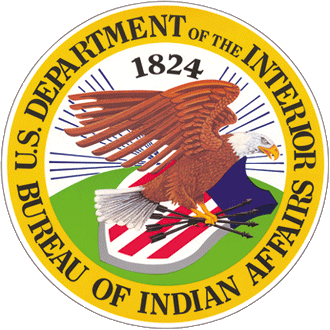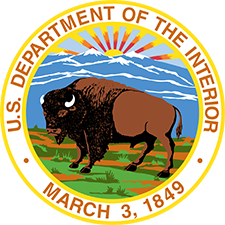Hopi Tribe of Arizona
 Indian Affairs - Office of Public Affairs
Indian Affairs - Office of Public Affairs
WASHINGTON – On October 28, 2020, Assistant Secretary – Indian Affairs Tara Katuk Mac Lean Sweeney, accompanied by several Trump Administration officials, met in Flagstaff, Arizona, with Chairman Timothy Nuvangyaoma of the Hopi Indian Tribe to sign a commitment letter for $5 million dollars towards an infrastructure project to reduce arsenic levels in drinking water on the Hopi reservation. Accompanying Chairman Nuvangyaoma were Executive Advisor to the Chairman Duane Humeyestewa; Carroll Onsae, general manager of Hopi Tribal Communications Inc. (HTC) and Hopi Utility Corporation (HUC); and HUC engineer Timothy Bodell, who is leading the Tribe’s water quality analysis.
Joining Assistant Secretary Sweeney from the Administration were Assistant to the President and Director of White House Intergovernmental Affairs Doug Hoelscher; Deputy Assistant to the President and Domestic Policy Council Jennie Lichter; U.S. Health and Human Services Deputy Secretary Eric Hargan; U.S. Indian Health Service Director Rear Admiral Michael Weahkee; U.S. Attorney for the District of Arizona Michael Bailey; and Kate Sullivan, Principal Deputy Assistant Attorney General, Office of Justice Programs, U.S. Department of Justice.
“It was an honor to join the Federal delegation in discussions with the Hopi Tribe, including the Chairman and other tribal leadership, to advance an important water quality project that will bring better health, improved infrastructure, and stronger communities to the Hopi people,” said Director Hoelscher.
“Clean, accessible drinking water is vital for the health of our Native communities,” said Assistant Secretary Tara Sweeney. “I am proud to announce that the Trump Administration has committed $5 million to the Hopi Arsenic Mitigation Project to reduce the levels of arsenic in water in three Hopi communities. This project has languished since 2008, but the Trump Administration made the Hopi Arsenic Mitigation Project a priority and is helping to move it forward.”
Arsenic is a naturally occurring element in the groundwater used by the Hopi communities of Second Mesa, First Mesa, Low Mountain and Keams Canyon. In 2001, the EPA adopted a new standard for concentrations of arsenic in drinking water of 10 parts per billion (ppb), replacing the old standard of 50 ppb.
In order to begin addressing the problem, EPA and the U.S. Indian Health Service (IHS) provided the Tribe with financial and technical assistance to implement a regional water supply delivery system. Named the “Hopi Arsenic Mitigation Project,” or HAMP, the system involves construction of wells at the Turquoise Trail region and installation of water lines to the areas of First Mesa and Second Mesa.
The Assistant Secretary – Indian Affairs advises the Secretary of the Interior on Indian Affairs policy issues, communicates policy to and oversees the programs of the BIA and the BIE, provides leadership in consultations with tribes, and serves as the DOI official for intra- and inter-departmental coordination and liaison within the Executive Branch on Indian matters.
The Bureau of Indian Affairs directly administers and funds tribally operated infrastructure, law enforcement and justice, social services (including child welfare), tribal governance, and trust land and natural and energy resources management programs for the nation’s federally recognized American Indian and Alaska Native tribes through four offices: Indian Services, Justice Services, Trust Services, and Field Operations.
####
https://www.bia.gov/as-ia/opa/online-press-release/trump-administration-provide-5-million-hopi-tribe-begin-work
Western Region
Overview
A swift overview of the Region’s tribes includes the O’odham, Yaqui, Yuman and Pai Tribes of Arizona’s low and mid deserts and Grand Canyon, and the Apache of the mid-deserts and mountain forests. The Hopi live on Arizona’s Colorado Plateau mesas. Nevada has many bands and tribes of Washoe, Shoshone and Paiute people. The many tribes and bands of Ute people are the inspiration for the name of the state of Utah.
 Indian Affairs - Office of Public Affairs
Indian Affairs - Office of Public Affairs
PHOENIX, Ariz. – The Bureau of Reclamation and the Bureau of Indian Affairs have approved an extension lease for the Navajo Generating Station (NGS) which enables operation of the coal-fired power plant to continue through December 22, 2019. Without the extension, activities to retire the plant would be required to begin in the coming year.
The Department of the Interior bureaus approved the extension lease following an environmental review which concluded earlier this week. The Navajo Generating Station Extension Lease Environmental Assessment (EA) and draft Findings of No Significant Impact were issued for public review and comment from October 5 to November 3, 2017. Comments were received from 10 entities. Minor corrections and clarifications to the EA were made where appropriate.
Under the extension lease approved today, coal combustion at NGS will cease by December 22, 2019. Retirement of the facility would then begin, to be completed by December 22, 2024. The lease provides five years for the Salt River Project Agricultural Improvement and Power District to complete plant retirement and 30 years for long-term monitoring and remediation.
While the extension lease does not authorize coal combustion after December 22, 2019, efforts are continuing between the Navajo Nation and NGS stakeholders to develop agreements for post-2019 operations, which would require appropriate approvals and environmental review. Reclamation and BIA are monitoring developments to anticipate potential impacts to those who historically have received benefits from NGS operations, including Navajo and Hopi stakeholders and other Tribal interests.
An electronic copy of the revised EA and signed FONSIs are available at www.usbr.gov/ngs.
###
https://www.bia.gov/as-ia/opa/online-press-release/navajo-generating-station-extension-lease-approved-securing


